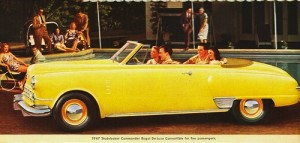 Frequent readers of this blog know that I am in the midst of a series of posts dealing with core mission in the arts. (The Buggy Whip Lesson: Recognizing a Mission Crisis, The Metamission of Arts Institutions, The Old Ball Game, Examining the Mission Model) I’ve discussed many aspects of the need for arts organizations to re-imagine their role in the world. This one does so as well, with an eye on how changing times can make a venerable “mission model” become out of step with the times.
Frequent readers of this blog know that I am in the midst of a series of posts dealing with core mission in the arts. (The Buggy Whip Lesson: Recognizing a Mission Crisis, The Metamission of Arts Institutions, The Old Ball Game, Examining the Mission Model) I’ve discussed many aspects of the need for arts organizations to re-imagine their role in the world. This one does so as well, with an eye on how changing times can make a venerable “mission model” become out of step with the times.
Studebaker, for those of you younger than “a certain age,” was a successful and reasonably innovative company making automobiles in the post-World War II era. They began as a wagon and buggy manufacturer and successfully made the transition to horseless carriages in the early Twentieth Century. They were not, however, able to make the transition to cars for the 1960’s and went out of business in that decade.
Thinking about this once-influential old company made me consider whether some missions may simply not be good fits for changed times. Perhaps I am saying the same thing that I’ve said in other posts, but it may be that the changing demographics, economics, and social expectations cited in those earlier posts simply have made the mid-Twentieth Century approach to arts presentation unwieldy for today in a way that Studebaker was not able to navigate in the 1960’s. That arts model was authority-based, rooted in a society that appeared to be fairly homogeneous (although the appearance was a forced one), and dependent upon relatively low labor costs and significant support from a wealthy class committed to supporting a cultural expression they saw as their own.
Institutions need to adapt to significantly changed circumstances . . . if they can. It may well be time to “trade in the Studebaker” of our didactic large organizations and remake ourselves in ways that better fit with the realities of the Twenty-first Century. Whether or not that’s possible is the big unknown for the arts industry’s future.
Engage!
Doug
- Photo:

 Some rights reserved by aldenjewell
Some rights reserved by aldenjewell

Thanks Doug,
I heartily agree! The UMass Arts Extension Service held a symposium on Sept. 26th called: Arts Policy on the Ground: The Impact of the National Endowment for the Arts which included the launch of our new National Arts Policy Archive and Library (NAPAAL)and 40th Anniversary event. NAPAAL features materials from the NEA of which three distinct areas were highlighted, including Jazz and the NEA, Public Art and Design. and Audience Participation.
The NEA’s Director of Research & Publications, Sunil Iyengar, not only unveiled their most recent Survey in Arts Participation, but he moderated a lively panel which addressed the reality that times are changing and underscored that the same old models (cars and otherwise) must evolve and are evolving. More than just speak to the choir, panelist Howard Herring, Director of New World Symphony in Miami, gave a series of exciting examples of how his symphony is thriving by reaching out in new ways, replacing tradition with innovation.
We need to do and share more of this work, and I welcome hearing what others are doing to build existing audiences, attract new audiences, engage and excite a new generation of arts enthusiasts, support local artists of all stripes, and grow the notion that the arts are vital, relevant and vibrant parts of our civic and personal lives. These are exciting times.
The video from the Arts Policy on the Ground Symposium will appear on our new National Arts Policy Archive and Library in a week or so (editing is underway!) at the url http://www.library.umass.edu/spcoll/umarmot/?s=NAPAAL&go=Find, until then, you can hear Howard Herring on NPR at: http://www.wnyc.org/radio/#/streams/wnyc-am820
Dee Boyle-Clapp
Arts Extension Service